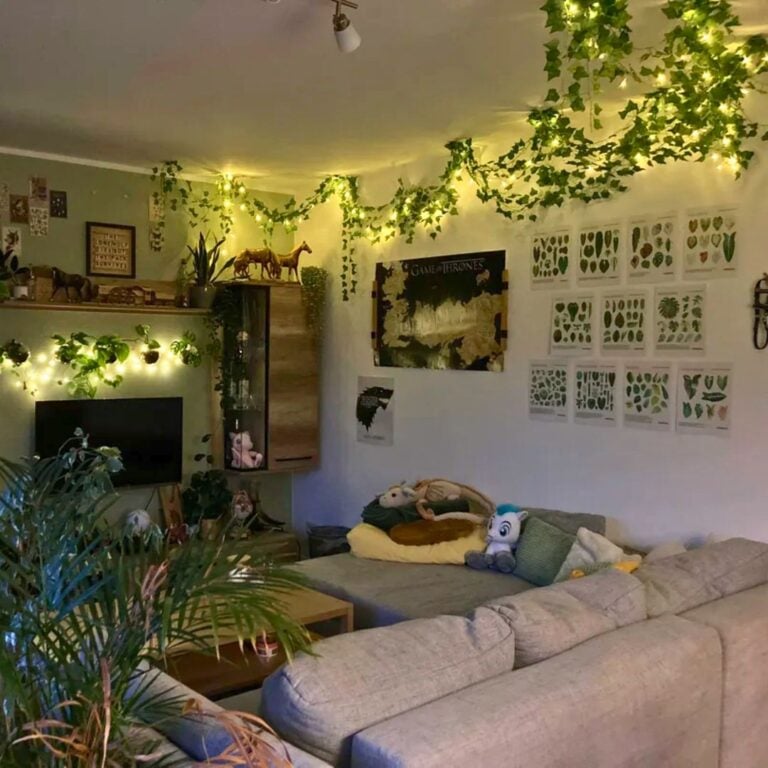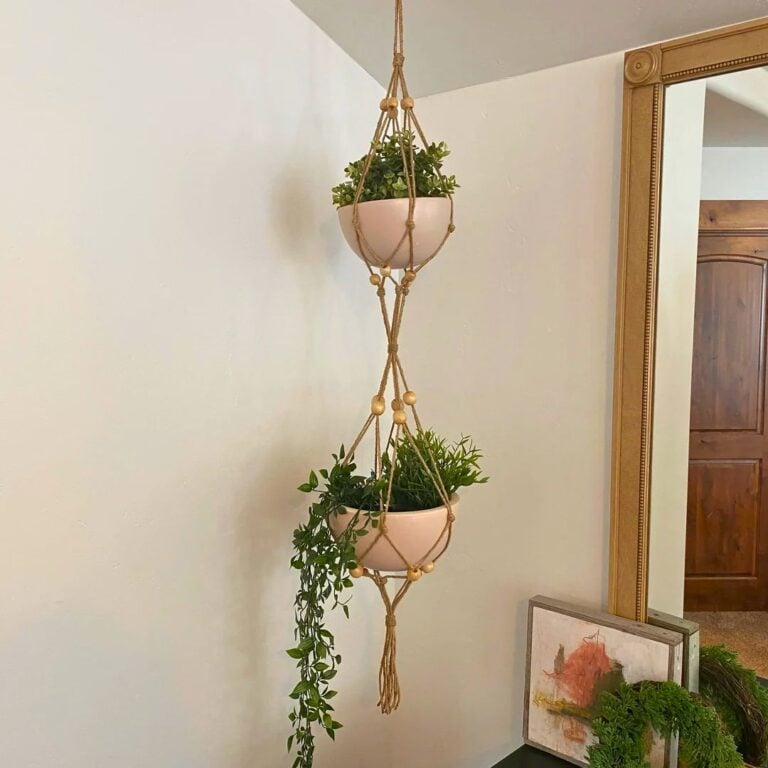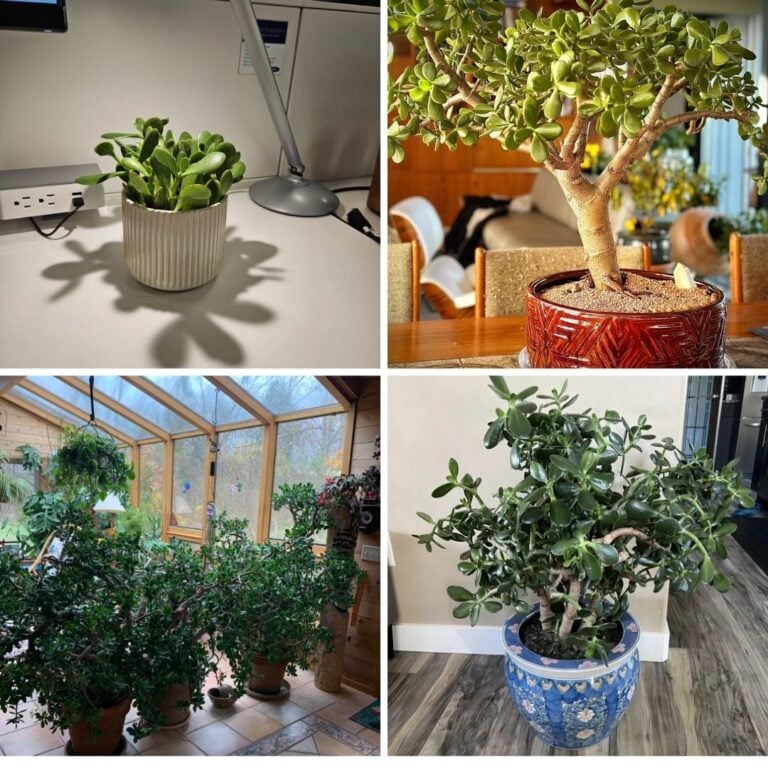9 Houseplant Styling Tips to Brighten Up Summer Rooms
I just love adding plants to my home, especially when summer rolls around. They make every room look fresh, full of life, and honestly, who doesn’t want to feel a bit more relaxed and happy in their own space?
Bringing plants indoors is such an easy way to brighten up any room and make it feel more inviting. With just a few simple tricks, I get to enjoy a little slice of nature inside all summer.
Please note: Simplify Plants is reader-supported. As an Amazon Associate, I earn from qualifying purchases made by our readers with no extra cost added to you all! Some links in the post are affiliate links and I get a commission from purchases made through links in the post.
1) Use colorful pots to add vibrancy

There’s something about bright, colorful pots that just makes a room pop. A yellow or blue pot can turn even a plain green plant into a little showstopper.
Mixing colors is fun for me—sometimes I’ll group together pots in different shades for a playful look. If my furniture is neutral, those bold pots are like instant mood boosters.
Patterns are fair game too. I’ll try stripes or polka dots when I’m feeling a bit more adventurous.
I usually pick colors that match my room’s vibe. Soft pastels for calm days, or brighter reds and greens when I want some extra energy in the air.
Sometimes I just repaint old pots to fit whatever color mood I’m in. It’s such a simple way to refresh a space without buying more plants.
I even switch up my pots for the season—coral, turquoise, and orange in summer because, well, why not? Those colors just feel like sunshine.
If I want the plant to stand out, I’ll stick with a plain white pot. But when the room needs a little cheer, I let the pots do the talking.
Just a handful of colorful pots, and suddenly the whole space feels brighter and more welcoming.
2) Group plants with varying leaf shapes

When I want my room to feel more alive, I like to group plants with different leaf shapes together. Mixing thin, spiky leaves with big, round ones always catches the eye.
I’ll put a tall, slender plant next to something bushier with wide leaves. This contrast really helps each plant stand out.
Even small differences—like ruffled edges or glossy textures—make the whole arrangement pop. I notice that grouping plants this way adds a lot of variety to shelves and tables.
If I stick to just one leaf shape, the display can end up looking a bit flat. Sometimes, I’ll combine trailing plants like pothos with upright ones like snake plants.
The mix of shapes makes even a little corner feel lively and interesting. It’s surprising how much difference a few different leaf styles can make.
3) Incorporate hanging planters for vertical interest

I’m a big fan of hanging planters for adding height and dimension. They let me use those awkward empty spots—corners, near windows, you know the ones.
When plants hang from the ceiling or wall, the room feels taller and more lively. I usually go for trailing plants like pothos or string of pearls.
I make sure to use sturdy hooks and brackets—no one wants a planter crashing down. And I try to find spots with decent light, but not too much sun.
With hanging planters, I can play around with different heights. Grouping a few together makes the whole display more dynamic.
Colorful pots or macrame hangers add a little extra flair. Even in small rooms, hanging planters let me squeeze in more greenery without crowding shelves or floors.
4) Add succulents for low-maintenance charm

Succulents are a lifesaver for anyone who forgets to water (like me, sometimes). They’re easy to care for and look great wherever I put them.
Most just need a sunny spot and a splash of water now and then. I’ll line up a few on a windowsill or group them in a tray for a cute mini garden.
They come in so many shapes and colors, it’s honestly hard to choose. Succulents don’t take up much room, so they fit perfectly on small shelves or desks.
If I forget to water them, they still seem to hang in there. It’s really simple to create a bright, cheerful look with just a few small plants.
Sometimes I’ll use colorful pots to make them stand out even more. Or I’ll plant a mix of succulents in one big container for a little variety.
They grow slowly, so there’s no rush to repot. Succulents work well in bedrooms, kitchens, or even bathrooms if there’s enough light.
Cleaning is a breeze—just a quick wipe with a soft cloth if they get dusty. By choosing succulents, I get all the green I want without much fuss.
5) Mix flowering plants like geraniums and begonias

There’s nothing like flowering plants to add a splash of color indoors. Geraniums bring those bright reds, pinks, and whites, while begonias have both lovely blooms and interesting leaves.
I’ll set a geranium on one end of the windowsill and a begonia on the other. Mixing them together just makes the whole area feel more lively.
These flowers really pop against the green leaves of my other plants. They break up big spaces and draw your eye.
Both geraniums and begonias love bright light, so I keep them near a sunny window, but not in harsh direct sun.
Watering matters—I let the top inch of soil dry out before giving them a drink. This keeps the blooms looking their best.
Sometimes I group smaller pots on a tray for a mini-garden effect. It works great on shelves or tables, and people always notice the bold colors.
Every few weeks, I’ll move them around for a fresh look and to make sure each plant gets enough light. Mixing flowering plants like geraniums and begonias is a super easy way to make any summer room feel brighter.
6) Place snake plants in corners for height

Snake plants are my go-to for adding height and a modern touch. Their tall, upright leaves make any room look put-together with almost zero effort.
When I want to fill a corner, I just pop a snake plant in there. It draws the eye up and makes the space feel taller—plus, it barely takes up any floor space.
Snake plants are low-maintenance, so I don’t worry about watering too often. They’re happy in both bright and shady corners.
I usually stick with a simple pot because the leaves are bold enough on their own. Corners that looked bare suddenly feel finished and welcoming.
They’re supposed to help clean the air, too, which is a nice bonus—especially in summer when the windows are open.
If I want to get fancy, I’ll pair a tall snake plant with some shorter plants nearby. The mix of heights and textures makes the corner stand out and feels more styled.
7) Use trailing Pothos or Ivy on shelves

Ivy is a classic for making shelves look alive. Those long vines just tumble over the edge and add a soft, green touch to the room.
I usually go for English ivy or pothos since they’re easy to care for. They like indirect light and don’t need much water, which is perfect for busy days.
A pot of ivy on a shelf adds instant movement. I let the vines hang down and sometimes drape them across books or frames—it looks relaxed, not staged.
I try not to crowd the ivy so the vines have room to grow and move. This helps the plant stay healthy and look its best.
Mixing pots with different shades of green adds even more interest. Light green leaves next to darker ones really catch the sunlight.
If the vines get too long, I just trim them back a bit. Regular trimming keeps ivy full and bushy.
Every so often, I’ll wipe the leaves clean with a soft cloth. Shiny leaves reflect light better and brighten up the whole shelf.
Using trailing ivy is honestly one of my favorite tricks for making shelves pop in the summer. It’s easy, looks great, and brings life to any space.
8) Combine ferns with palms for texture

Ferns and palms together? Yes, please. The mix of fine, feathery fronds from ferns with the bold, fan-shaped leaves of palms creates instant texture and interest.
I like to put a fern on a stool right next to a palm in a taller pot. The different shapes and heights make the corner feel full and inviting.
Ferns are bushy and soft, while palms have that stiff, sculptural look. I’ll mix Boston ferns with parlor palms or a small Areca palm for variety.
I make sure both plants have enough space and light. Ferns prefer more moisture and shade, palms like brighter, indirect light.
Using different pots and plant stands adds layers and keeps things tidy. Mixing these plants isn’t hard—I just pick two healthy ones, set them up, and adjust until it feels right.
It’s a quick way to make any summer room feel more styled and a little more lush.
9) Add a large monstera as a statement piece

A big monstera plant just makes any room feel fresh and modern. When I bring in a large monstera, it pretty much steals the show. Those big, glossy leaves? You can’t help but notice them.
I like to put my monstera in a bright spot with lots of indirect sunlight. Near a window usually does the trick. The leaves almost glow when sunlight floats through them.
For pots, I usually stick with simple, neutral designs so the plant pops even more. White or clay pots keep things light and clean, which I really like.
Monstera plants need enough space to spread out. I try not to crowd mine in a corner. The leaf shapes deserve to be shown off.
Cleaning is pretty simple. I just wipe the leaves gently with a damp cloth to keep them shiny. Happy leaves, happy plant.
Even if I already have other plants, a big monstera always adds something special. It brings a bold, tropical vibe without making things feel cluttered.
This plant grows well indoors, which makes it a good fit for all kinds of homes and apartments. I love how it brightens up my summer room and honestly, it just lifts my mood.
Understanding Plant Light Needs
I always try to make sure my plants get the right amount of light. It can be a little tricky sometimes, but figuring out their needs helps every room look brighter and more alive.
How Sunlight Impacts Indoor Plants
Sunlight gives plants the energy they need to grow. Not every plant wants the same amount, though. Succulents and cacti need plenty of bright, direct sunlight, while ferns and snake plants are fine with less or even just some shade.
I check which direction my windows face before placing anything:
- South-facing windows: Best for sun-loving plants.
- East or west-facing windows: Good for most houseplants.
- North-facing windows: Best for plants that like low light.
If a spot’s too dark, I’ll add a grow light to help out. I also turn my plants every week so they get even light on all sides.
Recognizing Signs of Too Much or Too Little Light
I try to notice changes in my plants. Brown, crispy leaf tips or faded colors usually mean too much sun. But if I see yellow leaves, slow growth, or stems stretching for the window, that’s not enough light.
If a plant looks a little off, I move it closer to or farther from the window. Here’s a quick cheat sheet I use:
| Sign | Possible Cause | What I Do |
|---|---|---|
| Leaf burn, scorched spots | Too much light | Move out of direct sun |
| Pale, weak, or leggy growth | Not enough light | Move to brighter spot |
| Leaves dropping | Light is too weak or too strong | Adjust position and monitor |
I check on my plants often and make small changes when needed. It helps me catch problems before they get worse.
Seasonal Plant Care for Vibrant Spaces

I keep my rooms lively in summer by updating my plant care and switching up displays to fit the season. Bright light and warm air mean I have to adjust for both plant health and style.
Summer Watering and Humidity Adjustments
Hot weather dries out soil faster. I check my plants’ soil more often in the summer. If the top inch is dry, I water them. For succulents, I let the soil dry out a bit more before watering.
Table: My Summer Watering Tips
| Plant Type | Watering Frequency | Extra Notes |
|---|---|---|
| Tropical | 2-3 times per week | Mist leaves for humidity |
| Succulent/Cacti | Once every 7-10 days | Avoid soggy roots |
| Ferns | Keep soil moist | Use a pebble tray for water |
Humidity matters too. I use a spray bottle to mist leafy plants a few times a week. Grouping plants together helps the air stay a bit more humid around them.
Refreshing Plant Displays for a Sunny Look
Summer is the perfect time to give my plant displays a fresh update. I move sun-lovers closer to bright windows. For low-light plants, I use sheer curtains to soften the harsh rays.
I’m a fan of colorful pots and baskets for a cheerful look. Yellow, blue, and terracotta containers always make things feel summery.
Sometimes I just throw together a quick arrangement:
- Gather 3-5 small plants of different heights.
- Put them on a tray or shelf for a mini indoor garden.
- Add a little decorative touch, like a lantern or a seashell.
Changing a plant’s place or adding a bit of new greenery makes a room feel new again. When I switch things up often, my space stays lively all season.
Frequently Asked Questions
I love using bright, colorful pots and grouping plants with different textures to liven up my spaces. Arranging flowering plants and using hanging planters lets me decorate even my smaller rooms without taking up too much floor space.
What are some creative ways to decorate with indoor plants?
I like to match plant pots to my room’s color scheme. For a playful look, I mix pots in bold colors and add plants with unique leaves.
I sometimes use macrame hangers to let my greenery dangle and create a cozy vibe.
Can you suggest some plant arrangement ideas for a small living room?
I often group small succulents together on a shelf or side table. Placing a single, striking flowering plant like a begonia on a coffee table adds color without taking up space.
I also use vertical shelves to stack different plants up the wall.
How can I display multiple plants in a limited space?
I stack plants on tiered plant stands to fit more into one corner. Hanging planters from the ceiling or wall also frees up my surfaces.
I use window ledges for sun-loving plants, which is great for making the most of small rooms.
What are some feng shui tips for placing plants in a home?
I place healthy, green plants in corners to soften sharp edges and improve flow. In my entryway, a small plant brings in good energy right by the door.
I keep plants away from cluttered or blocked areas to support a peaceful atmosphere.
What’s the best way to incorporate plants into home decor?
I match pot styles to my furniture for a simple upgrade. Mixing different plant heights and leaf textures gives the room more dimension.
I sometimes add a flowering plant to my dining table or kitchen counter for a natural accent.
How can plants be used to enhance the aesthetics of a room during summer?
For summer, I love using brightly colored planters—they really pop against the sunlight. Picking out plants with cheerful blooms like geraniums always seems to lift the mood.
Sometimes I’ll group a few plants together on a sunny windowsill, and it turns into this lively little display. Honestly, just tucking some greenery into corners or window nooks makes a room feel so much fresher and more welcoming.
Recommended Garden Supplies
| Product Image | Our Recommended Gardening Supplies | Check Offers! |
|---|---|---|
Top Top
Top
Top
Top
Top
Top
Top
Top | rePotme Houseplant and Tropical Classic Potting Soil Mix | Check Offer On Amazon |
 Top
Top
Top
Top
Top
Top
Top
Top | Espoma Organic Indoor Plant Food | Check Offer On Amazon |
 Top
Top
Top
Top
Top
Top
Top
Top | GooingTop LED Grow Light 6000K Full Spectrum Clip Plant Growing Lamp | Check Offer On Amazon |
 Top
Top
Top
Top
Top
Top
Top
Top | Soil Moisture Meter | Check Offer On Amazon |
 Top
Top
Top
Top
Top
Top
Top
Top | Govee Hygrometer Thermometer, Bluetooth Enabled! | Check Offer On Amazon |
 Top
Top | LEVOIT Humidifiers for Large Room(Best For Plants) | Check Offer On Amazon |
 Top
Top
Top
Top
Top
Top
Top
Top | Upgraded DIY Automatic Drip Irrigation Kit, 15 Potted Houseplants Support | Check Offer On Amazon |
 Top
Top
Top
Top
Top
Top
Top
Top | Stainless Steel Heavy Duty Gardening Tool Set | Check Offer On Amazon |
 Top
Top
Top
Top
Top
Top
Top
Top | Bonide Insecticidal Soap | Check Offer On Amazon |
 Top
Top
Top
Top
Top
Top
Top
Top | Bonide 32 oz Spray Neem Oil for Organic Gardening | Check Offer On Amazon |
 Top
Top
Top
Top
Top
Top
Top
Top | Garden Safe Fungicide | Check Offer On Amazon |




